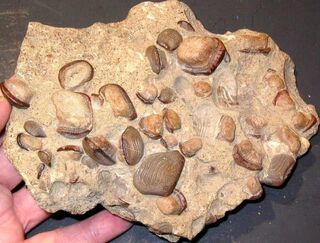
Ptychodus marginalis teeth. Trinity River, Dallas County, Eagleford shale. There are 43 teeth in the matrix.
Ptychodus is an extinct genus of shark. Commonly found in the Midwest U.S.
Taxonomy and Species[]
The genus Ptychodus is represented in the fossil records of Asia, Europe, Africa and the Americas. In North America, they are generously represented in Texas and the Western Interior Seaway. Welton &: Farish (1993) ascribed ten species to the Cretaceous of Texas:
- Ptychodus anonymus WILLISTON 1900 (Cenomanian-Turonian)
- Ptychodus connellyi MACLEOD & LAUGHTER 1980 (Campanian)
- Ptychodus decurrens AGASSIZ 1843 (Albian-Cenomanian)
- Ptychodus latissimus AGASSIZ 1843 (Coniacian-Campanian)
- Ptychodus mammillaris AGASSIZ 1835 (Coniacian)
- Ptychodus mortoni AGASSIZ 1839 ( Coniacian-Santonian)
- Ptychodus occidentalis LEIDY 1868 (Cenomanian-Turonian)
- Ptychodus polygyrus AGASSIZ 1839 (Turonian)
- Ptychodus rugosus DIXON 1850 (Santonian)
- Ptychodus whipplei MARCOU 1858 (Turonian-Coniacian)
In addition to some of the above, the Kansas chalk also yields Ptychodus martini WILLISTON 1898 from Coniacian exposures.
Ever since they were first described in the mid 1880's, Ptychodid sharks have been a puzzle, and it is still uncertain whether they are more closely related to sharks or rays. Generally, they are known only from isolated teeth in late Cretaceous (Albian through Campanian) deposits. Several more or less complete jaw plates, consisting of a hundred or more teeth, have also been found. In a few cases, the teeth are associated with vertebrae and dermal scales that are very similar to those of. The current view of the family Ptychodontidae is that they are related to hybodont sharks.
Fossil Teeth[]
The teeth of Ptychodus are arranged parallel, interlocking rows which form a broad crushing surface on both the upper and lower jaws. The largest teeth are found in the upper medial tooth row. The crown of the tooth ranges from nearly flat in some species, to a strongly developed cusp in others. The crown is expanded to cover the weakly bilobate root on all faces and always bears a series of distinctively radiating or transverse enameloid ridges surrounded by a marginal area of varying width. Species of Ptychodus are defined on the basis of crown shape and cusp development. According to Cappetta (1987), the flatter teeth of Ptychodus latissimus and P. polygyrus formed grindstone-like plates that were ideal for crushing benthic mollusks with thick shells. By elevating the cusp above the basal surface of the tooth, Ptychodus rugosus and P. mortoni may have been better equipped to attack less well protected prey such as ammonites. Wear patterns on P. mortoni teeth show that they were used to crush hard-shelled prey. Coprolite-like structures composed of the finely crushed shells of immature inoceramids in the suggest that ptychodids may have preferred these small mollusks to the thicker shelled adults.
Smoky Hill Chalk[]
Three species of ptychodids are known from the Smoky Hill chalk. Ptychodus mortoni is by far the most common. P. mortoni is found in the lower 1/3 of the chalk (latest Coniacian). Ptychodus anonymus is also found in the low chalk but is not as common and disappears from the Western Interior Seaway before P. mortoni. P. martini (named for his associate, H.T. Martin) is a very rare but well documented species. A nearly complete jaw plate was described by Williston (1898). This specimen, however, has been largely ignored in other literature. Stratigraphic information (Stewart, 1990) from isolated teeth found since then indicate that the species is found only in the lower 1/4 of the chalk. A second pair of jaw plates (170 teeth) was found in 1998 and is in the process of being published.
Ptychodus anonymous teeth have a moderately inflated crown with about 12 transverse ridges extending across the apex. P. anonymus is considered by some workers to be a subspecies of P. mammillaris. The marginal area surrounding the central cusp has a rugose or granular texture.
Ptychodus mortoni teeth have a high, conical cusp with a sharp apex. The shape of the cusp is similar to, though not as extreme, as that of P. whipplei. In P. mortoni, however, the ridges radiate in all directions from the apex and terminate just above the marginal area of the tooth. These radiating ridges distinguish these teeth from almost all other ptychodid species.
Ptychodus martini teeth have low, rounded cusps in the medial row, but become flattened toward the outer rows of the jaw plate. They have 8 or 9 transverse ridges that extend across the middle portion of the tooth. The surrounding marginal area has a rugose or granular texture.